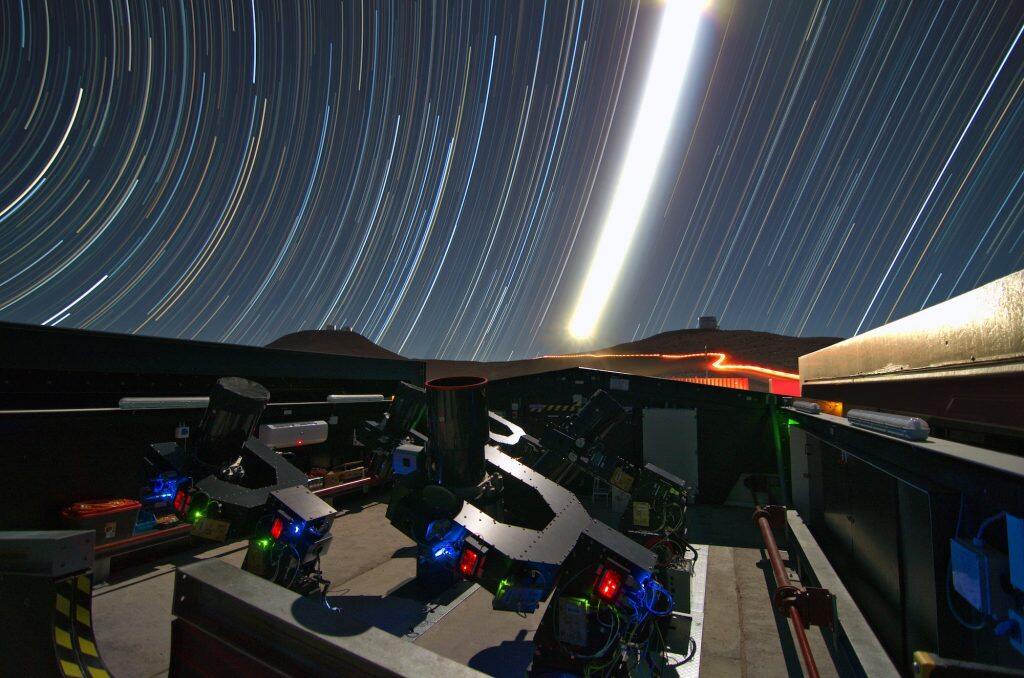- A planetary system in ‘resonance’, in which multiple planets regularly align, observed by international team including University of Warwick astronomers
- New study uses data from Next-Generation Transit Survey (NGTS), run by Warwick with UK and international partners


An international team of astronomers that includes researchers from the University of Warwick have revealed a system consisting of six exoplanets, five of which are locked in a rare rhythm around their central star. The researchers believe the system could provide important clues about how planets, including those in the Solar System, form and evolve.
The discovery was made using a combination of telescopes, including the University of Warwick-operated Next-Generation Transit Survey (NGTS).
The new research has revealed that the system TOI-178, a star some 200 light-years away in the constellation of Sculptor, boasts six exoplanets and that all but the one closest to the star are locked in a rhythmic dance as they move in their orbits. In other words, they are in resonance. This means that there are patterns that repeat themselves as the planets go around the star, with some planets aligning every few orbits. A similar resonance is observed in the orbits of three of Jupiter’s moons: Io, Europa and Ganymede. Io, the closest of the three to Jupiter, completes four full orbits around Jupiter for every orbit that Ganymede, the furthest away, makes, and two full orbits for every orbit Europa makes.
The five outer exoplanets of the TOI-178 system follow a much more complex chain of resonance, one of the longest yet discovered in a system of planets. While the three Jupiter moons are in a 4:2:1 resonance, the five outer planets in the TOI-178 system follow a 18:9:6:4:3 chain: while the second planet from the star (the first in the resonance chain) completes 18 orbits, the third planet from the start (second in the chain) completes 9 orbits, and so on. In fact, the scientists initially only found five planets in the system, but by following this resonant rhythm they calculated where in its orbit an additional planet would be when they next had a window to observe the system.
The study, led by Université de Genève and the University of Bern, Switzerland, is published today (25 January) in Astronomy & Astrophysics.
To investigate the system’s unusual architecture, the team used data from the state-of-the-art Next-Generation Transit Survey (NGTS) and SPECULOOS, both sited at the European Southern Observatory’s Paranal Observatory in Chile, the ESPRESSO instrument on the Very Large Telescope of the European Southern Observatory, as well as the European Space Agency’s CHEOPS satellite.
NGTS is a wide-field observing facility made of a compact ensemble of telescopes, designed to search for transiting planets on bright stars, run by the Universities of Warwick, Leicester, Cambridge, Queen’s University Belfast, Observatoire de Genève, DLR Berlin and Universidad de Chile. The Science and Technology Facilities Council (STFC) provides funding for the operation and maintenance of the NGTS, as well as funding for the team at the University of Warwick.
Edward Bryant, a PhD student in the Department of Physics at the University of Warwick, led the planning of the NGTS observations and producing the light curves from these observations that were contributed to the study. These light curves play an important role in fully understanding the planetary system, both in terms of how many planets there are, and how long they take to orbit the star.
Edward said: “The exciting aspect of this system is that five of the planets are interacting with each other. Over the next few years, we will be able to monitor the effect these interactions have on the orbits of the planets, which will allow us to place precise constraints on the masses and orbits of these planets. This future study of the system could even reveal the presence of additional planets. The NGTS facility is very well suited to undertake this future monitoring.
“The NGTS facility is dedicated to observing transits of exoplanets with a very high level of precision. These high precision transit observations are crucial to confirming the discoveries of new planets, such as the planets in the TOI-178 system, as well as improving the measurements of the planets’ radii. Two observations of TOI-178 were performed with NGTS, and in one of these a transit was detected. Both the observations contributed to the study and were an important part in understanding the structure of the TOI-178 planetary system.”
The first time the team observed TOI-178 they thought they had spotted two planets going around it in the same orbit. However, a closer look revealed something entirely different. “Through further observations we realised that there were not two planets orbiting the star at roughly the same distance from it, but rather multiple planets in a very special configuration,” says Adrien Leleu from the Université de Genève and the University of Bern, Switzerland, who led the study.
More than just an orbital curiosity, this dance of resonant planets provides clues about the system’s past. “The orbits in this system are very well ordered, which tells us that this system has evolved quite gently since its birth,” explains co-author Yann Alibert from the University of Bern. If the system had been significantly disturbed earlier in its life, for example by a giant impact, this fragile configuration of orbits would not have survived.
But even if the arrangement of the orbits is neat and well-ordered, the densities of the planets “are much more disorderly,” says Nathan Hara from the Université de Genève, Switzerland, who was also involved in the study. “It appears there is a planet as dense as the Earth right next to a very fluffy planet with half the density of Neptune, followed by a planet with the density of Neptune. It is not what we are used to.” In our Solar System, for example, the planets are neatly arranged, with the rocky, denser planets closer to the central star and the fluffy, low-density gas planets farther out.
“This contrast between the rhythmic harmony of the orbital motion and the disorderly densities certainly challenges our understanding of the formation and evolution of planetary systems,” says Leleu.








































